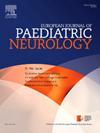Impact of lesion metrics and neurological functions on long-term cognitive outcome in childhood stroke
IF 2.3
3区 医学
Q3 CLINICAL NEUROLOGY
引用次数: 0
Abstract
The prevalence of cognitive impairment after childhood stroke is high and various risk factors influence long-term cognitive outcome. Whether and how risk factors are associated with cognitive outcome is still incompletely understood. This study investigated how lesion volume, lesion location and neurological functions at discharge, 6 months and 2 years after childhood stroke contribute to long-term cognitive outcome.
This observational study included patients after childhood arterial ischemic stroke. Long-term cognitive outcome (intelligence, processing speed, working memory) was assessed at least one year after stroke (Md = 3.52, IQR = 5.57). Neurological functions were measured using the pediatric stroke outcome measure at discharge, at 6-month and 2-year follow-up. Magnetic resonance imaging at stroke manifestation was applied to analyze acute to subacute lesion metrics (volume & location).
43 patients aged 6–23 years (Md = 6.17, IQR = 7.58) were enrolled in the study. Cognitive functions significantly correlated with lesion volume (processing speed: r = −.423, p = .005; working memory: r = −.478, p = .002). Working memory was worse if the left caudate nucleus was involved (U = 284.5, p < .001, d = 1.43). Long-term cognitive outcome correlated with neurological functions at discharge, 6-month and 2-year follow-up, although effects varied depending on the cognitive domain measured (discharge: r = .449, p = .003; 6-month; r = .509 to .538, p <.001; 2-year follow-up: r = .588 to .744, p <.001).
Long-term cognitive outcome was associated with lesion volume, lesion location and neurological functions. Our study adds to the determination of risk factors for long-term cognitive rehabilitation and highlights the need for the combined evaluation of neurological and cognitive outcome.
损伤指标和神经功能对儿童中风长期认知结果的影响
儿童中风后认知功能障碍的患病率很高,各种危险因素影响长期认知预后。风险因素是否以及如何与认知结果相关联仍不完全清楚。本研究调查了儿童中风后出院时、6个月和2年的病变体积、病变位置和神经功能对长期认知预后的影响。这项观察性研究包括儿童动脉缺血性卒中后的患者。卒中后至少一年评估长期认知结果(智力、处理速度、工作记忆)(Md = 3.52, IQR = 5.57)。在出院时、6个月和2年随访时使用小儿卒中结局测量法测量神经功能。应用脑卒中表现时的磁共振成像分析急性到亚急性病变指标(体积&;位置)。43例6 ~ 23岁患者(Md = 6.17, IQR = 7.58)入组研究。认知功能与病变体积(处理速度:r =−)显著相关。423, p = 0.005;工作记忆:r =−。478, p = .002)。当左尾状核受累时,工作记忆较差(U = 284.5, p <;.001, d = 1.43)。长期认知结果与出院、6个月和2年随访时的神经功能相关,尽管影响因所测量的认知领域而异(出院:r = .449, p = .003;6个月;R = .509 ~ .538, p <;2年随访:r = .588 ~ .744, p <.001)。长期认知结果与病变体积、病变位置和神经功能有关。我们的研究增加了长期认知康复的危险因素的确定,并强调了对神经和认知结果进行综合评估的必要性。
本文章由计算机程序翻译,如有差异,请以英文原文为准。
求助全文
约1分钟内获得全文
求助全文
来源期刊
CiteScore
6.30
自引率
3.20%
发文量
115
审稿时长
81 days
期刊介绍:
The European Journal of Paediatric Neurology is the Official Journal of the European Paediatric Neurology Society, successor to the long-established European Federation of Child Neurology Societies.
Under the guidance of a prestigious International editorial board, this multi-disciplinary journal publishes exciting clinical and experimental research in this rapidly expanding field. High quality papers written by leading experts encompass all the major diseases including epilepsy, movement disorders, neuromuscular disorders, neurodegenerative disorders and intellectual disability.
Other exciting highlights include articles on brain imaging and neonatal neurology, and the publication of regularly updated tables relating to the main groups of disorders.

 求助内容:
求助内容: 应助结果提醒方式:
应助结果提醒方式:


